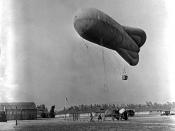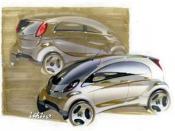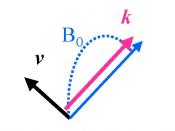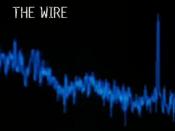Balloon Powered Vehicle The balloon powered vehicle was an experiment in which I was teamed up with a partner and we were asked to make four sketches of a balloon powered vehicle that we thought can make it across a wire tied up from each side of the classroom. My partner and I split up the four sketches, I was doing two sketches and my partner was doing two sketches. Sketches #1 and #2 were my ideas and Sketches #3 and #4 were my partners ideas each of our four sketches were in a title block format. The twist was we had a limited amount of materials. Our materials were one strip of tape, a popsicle stick, two pieces of straw, two paper clips, a balloon, and a rubber band.
While we were in our next class we were testing two of our sketches, Sketch #1 and Sketch#4. While were testing these two sketches we measuring the distance the balloon powered vehicle traveled across the wire and the time it took it to travel the distance.
Then when we had done that, we were figuring out to see which balloon powered vehicle had a better velocity out of Sketch#1 and Sketch #4. In order to figure out the velocity of the balloon powered vehicle we were using the formula for velocity, Velocity = Distance divided by Time.
My partners idea for his balloon powered vehicle Sketch#4 while experimenting it on the wire in the classroom traveled a total distance of 10 feet in 10 seconds. My idea for a balloon powered vehicle Sketch#1 while experimenting it on the wire in the classroom traveled a total distance of 6 feet in 4 seconds. With using the formula for velocity we will see which balloon powered vehicle sketch is had better velocity.
SketchesDistanceTimeVelocity V = D/T Sketch#410 feet10 seconds1 s Sketch#16 feet4 seconds1.5 s According to the information on the board the balloon powered vehicle that proved to have a greater velocity out of Sketch#1 and Sketch#4 was Sketch#1. We got this result because when we used the formula we substituted D with the amount of feet each sketch traveled and T with the amount of time it took to travel the distance. Sketch#4 got a total velocity of 1 s and Sketch#1 got a total velocity of 1.5 s since 1.5 is greater than 1 this proves that Sketch#1 has a greater velocity than Sketch#4.
I think that my partner and I could had improved our balloon powered vehicle more better because neither of our ideas succeeded to go al the way across the wire. A problem that we had with Sketch#1 balloon powered vehicle was that while trying to go across the wire the balloon was just spinning this all around the wire which was not allowing the balloon to travel that far. A way we could had fixed this problem was by using the second paper clip to hold the balloon more stable and to stay moving without spinning around the wire. The problem we had with Sketch#4 balloon powered vehicle was that it was stable but we did not blow enough air into the balloon so it did not travel that fast. A way we could have easily fixed this problem was by simply blowing a lot more air into the balloon so it could have traveled further and faster.
So when it came down to the conclusion after experimenting Sketches#1 and Sketches#4 on the wire tied up from each side of the classroom. We found out that Sketch#1 had greater velocity than Sketch#4 because Sketch#1 had a velocity of 1.5 and Sketch#4 had a velocity of 1 and 1.5 is greater than 1. That is why out of Sketch#1 and Sketch#4 the balloon powered vehicle that had the greater velocity was Sketch#1.





